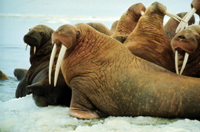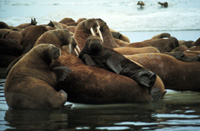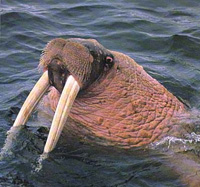Walrus
(Odobenus rosmarus)
IUCN STATUS (2010) - DATA DEFICIENT
Distribution and Numbers
Easily recognised by its long tusks, the walrus is the only living member of the Odobenidae family of pinnipeds and has two generally recognised subspecies. The Atlantic walrus (O.r. rosmarus) is found from the east Canadian Arctic eastwards to the Kara Sea. The Pacific walrus (O.r. divergens) is found in the north Pacific Ocean and in Arctic waters from the East Siberian Sea to the western Beaufort Sea, as well as in the Laptev Sea. It has been proposed by some scientists that the Laptev Sea population be given subspecific status as the Laptev walrus (O.r. laptevi) but this is not widely accepted. Accurate data on walrus abundance is not available but the most recent rough population estimates have been 22,500 Atlantic walruses (6,000 in Norway and Russia, 12,000 in Canada and 4,500 in Greenland), and a minimum of 200,000 Pacific walruses in eastern Russia and the United States. |
Status
Walruses are long-lived and have a relatively low reproductive rate, so their numbers are easily influenced by hunting and other mortality. Both subspecies of walrus have been subjected to intensive commercial hunting in the past for their blubber oil, tusk ivory and skins, leading to the extermination of local populations in some areas and severe depletion of others. Although commercial hunting has now ceased, other forms of hunting currently have the most direct and quantifiable impact on walrus populations. Native subsistence hunting of the walrus for its meat, skin, ivory, oil and other products has taken place for thousands of years and continues today. Lack of accurate information on walrus population numbers means that hunting quota levels may be having a detrimental effect on the species, particularly for the Atlantic walrus. Certainly the problem of walruses being "struck and lost" results in kill statistics that are very probably underestimated, figures of 30-42% having been quoted for the percentage of walruses killed in this way. |
 |
| Walruses are also conservative in their choice of habitat and food, so any reduction in these may have detrimental effects on their numbers. There are serious concerns that walrus numbers may be threatened by a loss of sea ice caused by global warming and environmental changes, the retreating sea ice reducing the availability of suitable habitat and food supply. Some concern has also been expressed at the effects of bottom trawling for flatfishes on walrus habitat near haulouts in Bristol Bay, dragging of the sea bed by fishermen having been known to disturb and destroy walrus feeding habitat. |
| Other potential threats to walrus populations include pollution and disturbance from oil and gas exploration and extraction, especially in the Bering and Chukchi Seas, around Svalbard and in the western Russian Arctic. Walruses are particularly at risk from oil spills as their staple diet of benthic invertebrates are known to accumulate hydrocarbons. High concentrations of metals, notably cadmium, lead and mercury, have been found in Atlantic and Pacific walruses, while high levels of organochlorines such as DDT and PCB have also been found in those walruses that eat seals. Disturbance from sources such as tourism and fisheries is also a concern, particularly as walrus calves may be trampled underfoot during disturbance-caused stampedes of hauled out walruses. Calves separated from their mothers in the first year of nursing are thought to have little chance of survival, and several haulouts have been completely abandoned by walruses due to disturbance. |
| The walrus is listed as an Appendix III species by Canada under CITES and as an Appendix II species under the Bern Convention. The Laptev walrus is listed as Data Deficient on the IUCN Red List. |
| Atlantic Walrus: Its numbers having been decimated in the past, mainly by European sealers and whalers, the Atlantic walrus has not been able to recover and is still well below its pre-exploitation level of several hundred thousand. It is currently believed that there are eight subpopulations of Atlantic walrus, scientists concluding in 1995 that four of these were thought to be stable or increasing, two to be declining and two to have unknown status. In 1995 it was calculated that the native kill of Atlantic walrus, including those struck and lost, totalled about 1,150 per year. The native kill of Atlantic walrus takes place mostly in Canada and Western Greenland. Hunting of walrus in Norwegian waters (including the Norwegian Arctic) and the Russian western Arctic has been banned since 1952 and 1956 respectively, although there is some poaching in Russia, especially since the collapse of the Soviet Union. There are also reports of a trade in walrus calves as part of the Russian exotic animal market. |
| A survey of hunters and elders from Nunavut in the Canadian Arctic, released in September 2000, revealed that hunters had observed walruses and other wildlife with a large number of deformities, including swollen internal organs and missing patches of skin. A strange occurrence of "round wounds" was observed in the skin of some walruses, and the analysis of a similar abnormality found in a walrus in March 2000 had pinpointed a strain of bacteria as the cause. Hunters also reported finding walruses with fluid or pus between their meat and fat or with unusual stomach contents, and even one walrus which had its gall bladder reversed and draining into its stomach. Changes in the colour of walrus meat and fat were also reported. The survey report recommended a specific system of monitoring for such abnormalities in the future, as well as further studies on affected animals. One possible reason suggested for these abnormalities is the high level of persistent organic pollutants (POPs) in the Canadian Arctic. |
| Pacific Walrus: Commercially exploited since the 18th century, the Pacific walrus has been substantially reduced in numbers and allowed to recover three times in the past 150 years. The population was most recently reduced to 50,000 - 100,000 in the mid-1950s. Conservation measures were initiated in both Russia and the United States in the 1960s and these have allowed the subspecies to attain levels close to those it had before exploitation. Trends in life history parameters indicate however that the population may now be declining. The lack of a proper range-wide survey since 1990 along with reports by scientists and native hunters of lower calf production and survival has led to increased concern for the population's status. |

Photo: Kathy Frost,
Alaska Department of Fish and Game |
Pacific walruses are killed by natives in Alaska, USA, and Chukotka, Russia. The number of walruses killed by native hunting declined after Russian ship-based hunts ceased in 1991. The latest year for which there are reasonably reliable figures covering both the United States and Russian hunts show that 2,501 walruses were killed in Alaska and 941 in Chukotka during 1996. Taking into account those walruses that are struck and lost, the total hunting-caused mortality for 1996 was estimated at 5,934. Preliminary analyses show that the total number of walruses killed in 1999 was similar to 1996. Native hunters in Alaska must only kill walruses for subsistence purposes or the creation of handicrafts and must fully utilise the walruses that they kill. The level of native hunting cannot be regulated by the federal government unless the population is found to be depleted. |
| The demand for carved and patterned walrus ivory ("scrimshaw") as trophies and trinkets has led to the problem of "head-hunting", the illegal killing of walruses purely for their tusks. A pair of tusks can bring US$300 or more, providing a strong financial incentive to head-hunt. A two-year federal undercover operation ended in 1992 with the arrests of a network of head-hunters and buyers in Alaska who were illegally trading tusks for money and drugs. In 1996 a survey discovered at least 160 headless walrus carcasses washed up on the beaches of northwest Alaska, while in 1998 a U.S. federal grand jury indicted 6 Alaskan walrus hunters on allegations of head-hunting. It is hoped that this problem and other related walrus conservation problems in Alaska will decline through greater co-management and cooperation between the authorities and Alaskan native communities. |
| Pacific walrus meat has been used for the past 40 years to feed foxes which are kept on government - subsidised fur farms in Chukotka. One estimate made by natives was of an annual kill of 10,000 - 12,000 walruses per year, but this may have been overstated. Recent investigations have found that much of the meat is left to waste and that there are no markets for the resultant fox furs. Fox farming operations in Chukotka are currently in decline due to economic recession. Local unemployment caused by the general economic situation and the closure of the farms has however led to a recent increase in illegal head-hunting. |
Lifestyle
The species is mostly found in shallow continental shelf waters, usually less than 100m deep. Walruses prefer to haul out on first-year ice with open leads or areas of open water, and the species therefore tends to follow the movement of the ice limits. It is also quite common however for both subspecies to haul out on land. There is usually seasonal segregation, males and females feeding in separate areas during the summer. The Pacific walrus population for example, virtually all of which is found in the Bering Sea during the mating season, splits up as the pack ice retreats northwards in April-May, mostly females and juveniles following the ice to the southern edge of the Chukchi Sea, while mostly males remain behind to feed in the Bering Sea. Some local populations however probably do not migrate. |
| Adult males make a number of taps, knocks, pulses and bell sounds under the water during the mating season. These are thought to be intended to attract females and to show superiority to other males, although some fighting also occurs between males at this time. Mating takes place in the water, usually in January - April, and pregnancy lasts 15-16 months. Females can only therefore give birth a maximum of once every two years, 3-4 years and more for older females. This results in a pregnancy rate that is much lower than that for other pinnipeds. Walrus calves are usually born on the pack ice in late April - early June with a coarse dark coat, having shed their white lanugo about 2-3 months before being born. The calf is nursed solely on milk for the first 6 months or so, before beginning to eat solid foods. Nursing mostly takes place in the water, but also sometimes on land or ice. The nursing period typically lasts for 2 years, weaning occurring gradually over a period of time. |
| The walrus' tusks are enlarged upper canine teeth and can reach 1m in length and weigh more than 5kg. These are used in threat displays and fighting, and also to help the walrus haul itself out onto the ice. Females and younger males have a relatively thick brown fur. Older males have a thinner coat of hair that allows you to see their skin, the skin colour varying from almost white in the cold water, due to a reduced blood flow, to a cinnamon-brown or pink-red colour out of the water. Walrus skin can be up to 6cm thick and adult males also have noticeable wart-like nodules on their chest, neck and shoulders. Walruses moult in June - August. They are highly social and gregarious, often hauling out in close-packed groups numbering in their hundreds and even thousands. |

Photo: Kathy Frost,
Alaska Department of Fish and Game |
| When threatened, walruses vigorously defend themselves, their calves and often their colleagues. Walruses feed mostly on invertebrates that live in or on the bottom sediments, almost exclusively on bivalve molluscs, such as clams, when these are available. The species' diet also includes worms, sea cucumbers, snails, crustaceans, and occasionally seals. Fish are eaten only rarely and the taking of the occasional bird has also been observed. The walrus uses its stiff whiskers to locate its food, often feeding in total darkness in the winter. Any food requiring to be dug out from the sediment is either rooted out by the walrus by using its snout, by jetting water at it with its mouth, or by waving its front flippers. The maximum recorded dive for a walrus is a depth of 113m for almost 25 minutes, but individuals are thought to be able to dive deeper than this. Walruses, particularly calves, are preyed upon by polar bears and killer whales. |
Statistics
Walrus measurements vary between populations but in general there is no significant difference in the body size of male Atlantic and Pacific walruses, whereas female Atlantic walruses have been found to be significantly longer than their Pacific counterparts. Adult male Atlantic walruses measure 3m in length and 1,200-1,500kg on average (maximum 2,000kg), while adult female Atlantic walruses measure 2.7m in length and 600-700kg on average (maximum over 1,000kg). Calves of both subspecies are born measuring 1.2m in length and weighing 60kg on average. Females reach sexual maturity at 4-10 years, males at 6-10 years, although males cannot compete successfully for females until they are about 15 years of age. Walruses can live to be at least 40 years of age.



